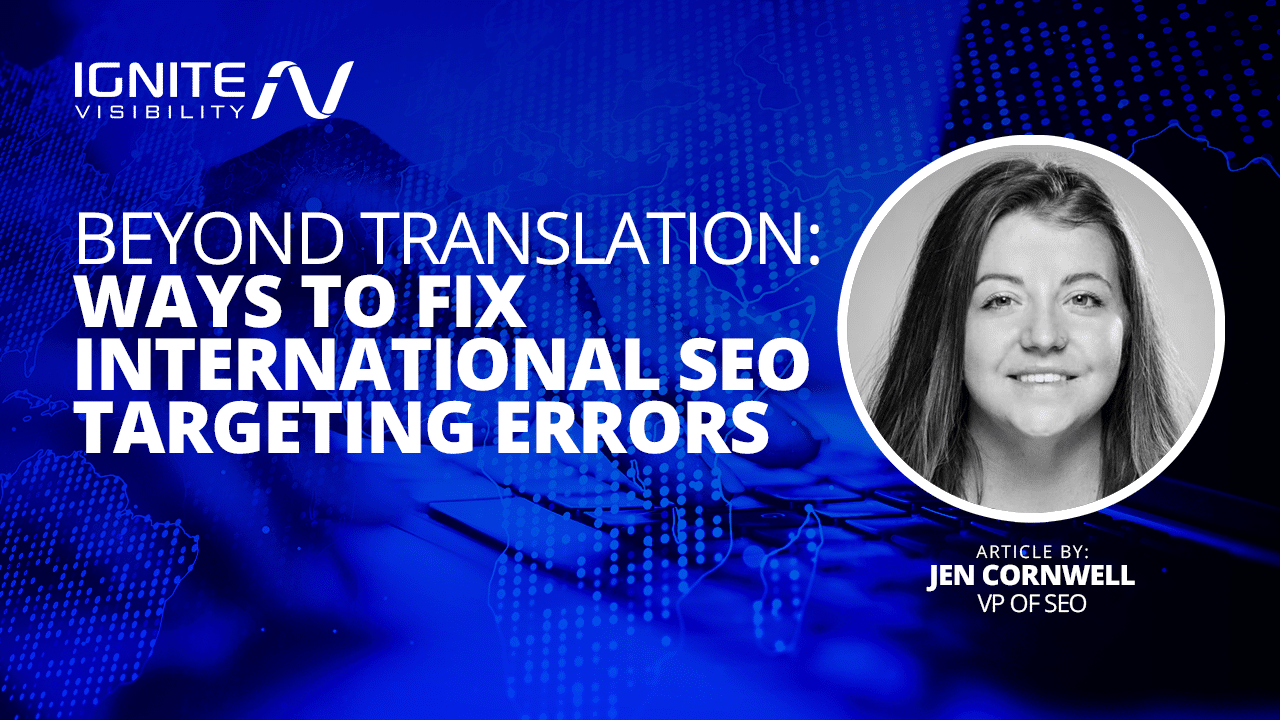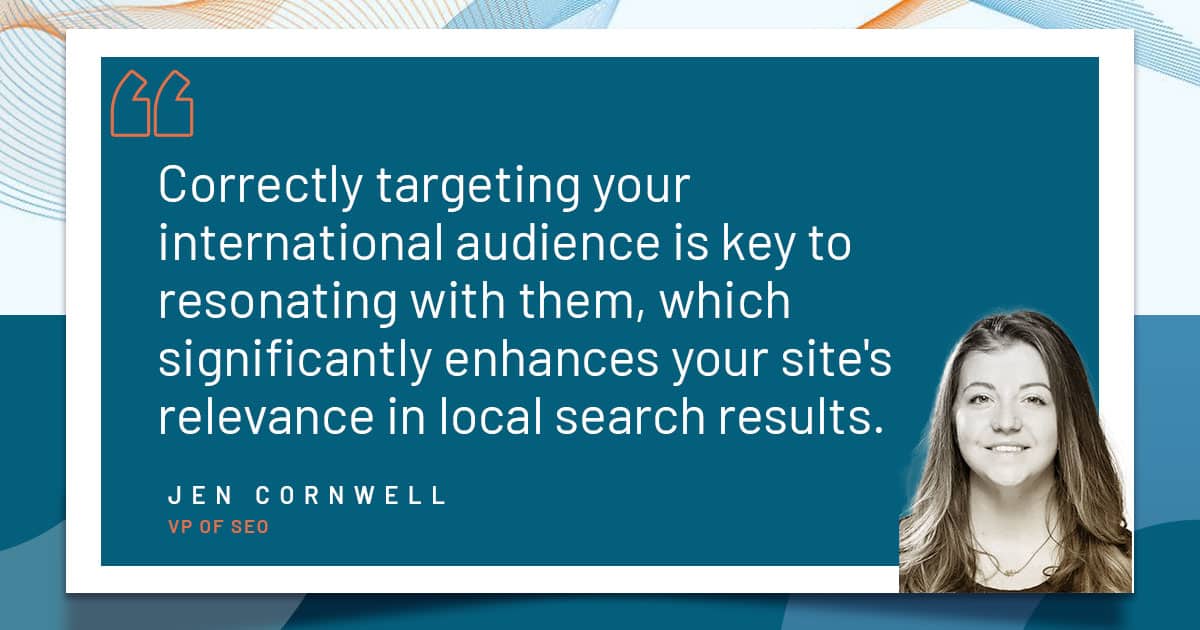Tackling SEO in your home country is one thing. International SEO targeting is another. With international SEO comes errors, and you need to know how to fix them.
What We’ll Cover:
- What is International SEO?
- International SEO Mistakes to Avoid
- Start Debugging International SEO Issues
- 4 Ways to Debug International SEO Targeting Issues
- FAQs: International SEO Targeting
What is International SEO?
First, let’s get into what international SEO is all about. What is international SEO, exactly?
Simply put, international SEO entails optimizing web pages and content for specific countries or languages, depending on the audiences you want to target.
If you want to connect with international audiences and potential customers, international SEO can be invaluable as you optimize for their countries and languages.
For instance, you might want to reach people in other countries that speak the same language as you, in which case you would develop campaigns targeting those particular countries.
In other cases, a business might simply attract audiences from the same geographic location as the business but who speak different languages, which would lead to a multilingual SEO campaign optimizing for different languages.
Other times, you might want to optimize for both.
In any case, while this type of SEO is potentially crucial for your site, there are some critical international SEO mistakes you’ll want to avoid. Different types of international SEO targeting errors and other problems can seriously compromise your campaigns, making it important to know how to identify and resolve these problems.
With the help of a comprehensive guide to international SEO, you can thrive with your online marketing strategy.
Let’s discuss a few international SEO mistakes to avoid, and how to fix them. That way, your pages can rank on the right search engine results pages.
Our Expert Insights on Understanding International SEO
International SEO Mistakes
There are multiple types of international SEO targeting issues that can lead to compromised marketing efforts. The following are some of the specific issues to avoid with international SEO campaigns.
1. Focusing Only on the U.S.
One of the main issues that can hurt international SEO campaigns is building a U.S.-centric campaign. If you want to target audiences all over the world or from different cultures, you must consider the differences on nearly every level.
Consider methods of communication across different cultures, methods of doing business, and other aspects that might differ from audience to audience.
2. Only Targeting Google
Google remains the leading search engine all, especially in the U.S. Because of this, many businesses located in the U.S. don’t tend to consider other international search engines.
The fact is that Google and Bing are far from the only search engines widely used in the world. For example, Chinese consumers tend to use Baidu, while Russian users like to search on Yandex.
Optimizing for these engines will help you expand your reach more effectively.
3. Incorrect Keyword Targeting
Don’t get lazy with your keyword research when targeting different languages. Consider the kind of phrasing people in other countries might use when performing searches with industry-related terms.
Also, keep in mind that English alone can vary from country to country—while Americans might call fried potato snacks “chips,” the British English variant is “crisps,” for example.
4. Poor Translation
Poorly translating content can make your optimization efforts ineffective in a number of ways.
First, the terms you translate might not even be what people would actually search for in their native language.
Additionally, poorly translated content will keep people from staying on your page, which can further hurt SEO as you see a spiked bounce rate.
Yet another way poor translation can hurt is by keeping people from moving any closer toward a sale, hurting your bottom line.
5. Legal Issues
Legal issues are particularly serious international SEO mistakes to avoid. The laws and regulations in different countries also vary, which you’ll want to account for in your content.
For instance, you might run into legal trouble in some countries by labeling your offerings as “the best” or by making any type of perceivable guarantee of results.
Debug International SEO Issues
Before we get started addressing how to fix hreflang tags with errors and other international SEO targeting issues, make sure you’re familiar with two terms:
What Are Hreflang Tags?
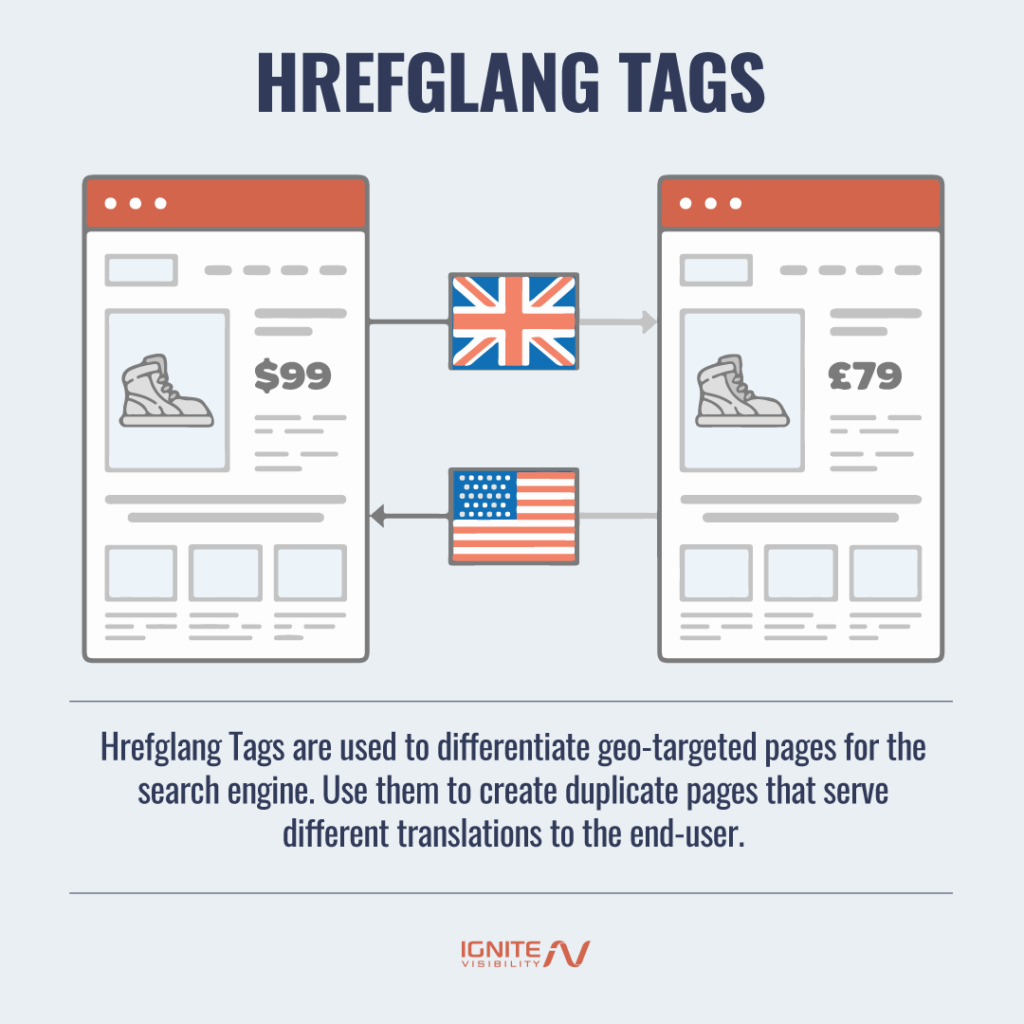
Google came out with hreflang tags in 2011. It was a way for web developers to differentiate geo-targeted pages for the search engine.
Why should you differentiate alternate pages for localized areas? It comes in handy when you serve diverse regions speaking different languages. In cases like this, incorporating hreflang tags lets you produce duplicate pages. These duplicate pages serve different translations to the end-user.
You can show hreflang tags in the following formats:
- HTML: <link rel=”alternate” hreflang=”lang_code”… >
- HTTP headers: <url1>; rel=”alternate”; hreflang=”lang_code_1″, <url2>; rel=”alternate”; hreflang=”lang_code_2″, …
- Sitemaps: xmlns:xhtml=”https://www.w3.org/1999/xhtml”
There are guidelines for hreflang tags, and any issues you may have could be an issue with one of these. These guidelines include:
- Language versions of the same page must list themselves and all other versions. Different pages have to point to each other.
- Developers must fully qualify alternate URLs, though they don’t need to have the same domain.
- You can list different versions of the same language. For example, you may want to differentiate between Australian vs. American English. Still, you need to identify a “catchall URL” for speakers of that language from a region you haven’t specified.
- You should add a “fallpage page” or a backup in case there is an unmatched language.
There are more guidelines for the different hreflang formats (HTML, HTTP headers, and sitemaps). Refer to Google Search Central for more about incorporating hreflang language codes.
What Are Canonical Tags?
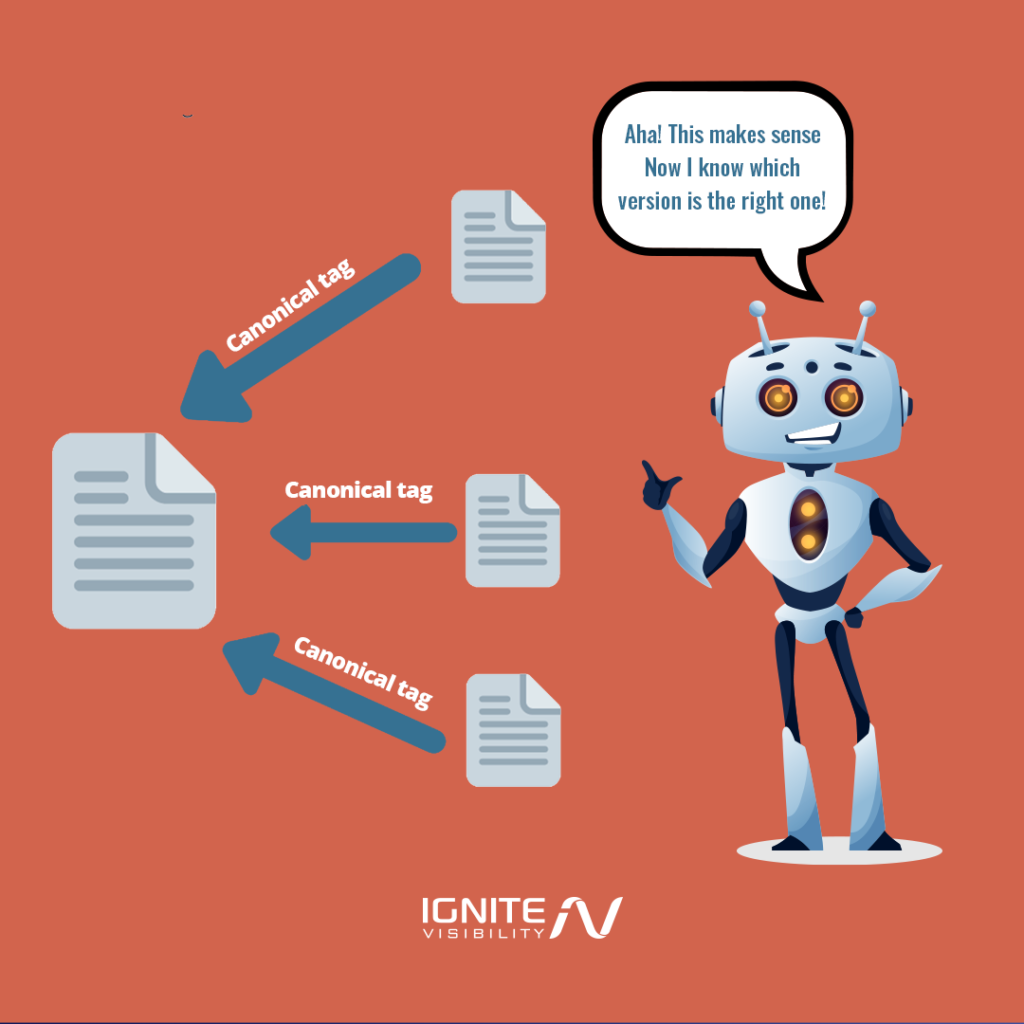
Canonical tags are the brainchild of search engines united (AKA Google, Microsoft, and Yahoo). Canonicals allow you to merge duplicate URLs for search engines, according to Google.
Google Search Central says it best: “If you have a single page that’s accessible by multiple URLs, or different pages with similar content, […] Google sees these as duplicate versions of the same page. Google will choose one URL as the canonical version and crawl that, and all other URLs will be considered duplicate URLs and crawled less often.”
It’s important to specify which URL Google should consider the canonical page. Otherwise, the search engine’s algorithm (AKA Googlebot) will make that choice for you. To be clear, Google may sometimes pick a different one than you specified as your preference. It will do this if it thinks another page is better as the canonical.

A canonical page doesn’t need to be exactly the same as its duplicate pages. For example, it can have differences in filtering or domain URL.
What if Googlebot picks your canonical URL for you?
In this case, Google chooses which URL it thinks is the most useful and complete resource for users. Google limits its crawling load on your site by prioritizing the canonical page. Google uses signals for usefulness like HTTP vs. HTTPS, URL inclusion in the sitemap, rel=canonical labeling, and more. (Google doesn’t like to spill all its secrets, of course.)
With a better understanding of hreflang tags and canonical tags and how they work, let’s get into why it’s essential to fix international SEO errors.
Why It’s Important to Debug International SEO Targeting Errors
Hreflang and canonical tag errors are super common. But that doesn’t mean you should ignore them.
What if you’re using an international SEO targeting strategy? You want to have the correct canonical and hreflang tags labeled for each country’s page.
This won’t impact your SERP ranking. However, hreflang and canonical tags are good identifiers. That’s why the Ignite team recommends debugging any canonical and hreflang issues you find.
While hreflang and canonical tags serve similar functions, they’re not the same thing. Messing with your URLs or coding can confuse Google, so you want to make sure you’re doing it right.
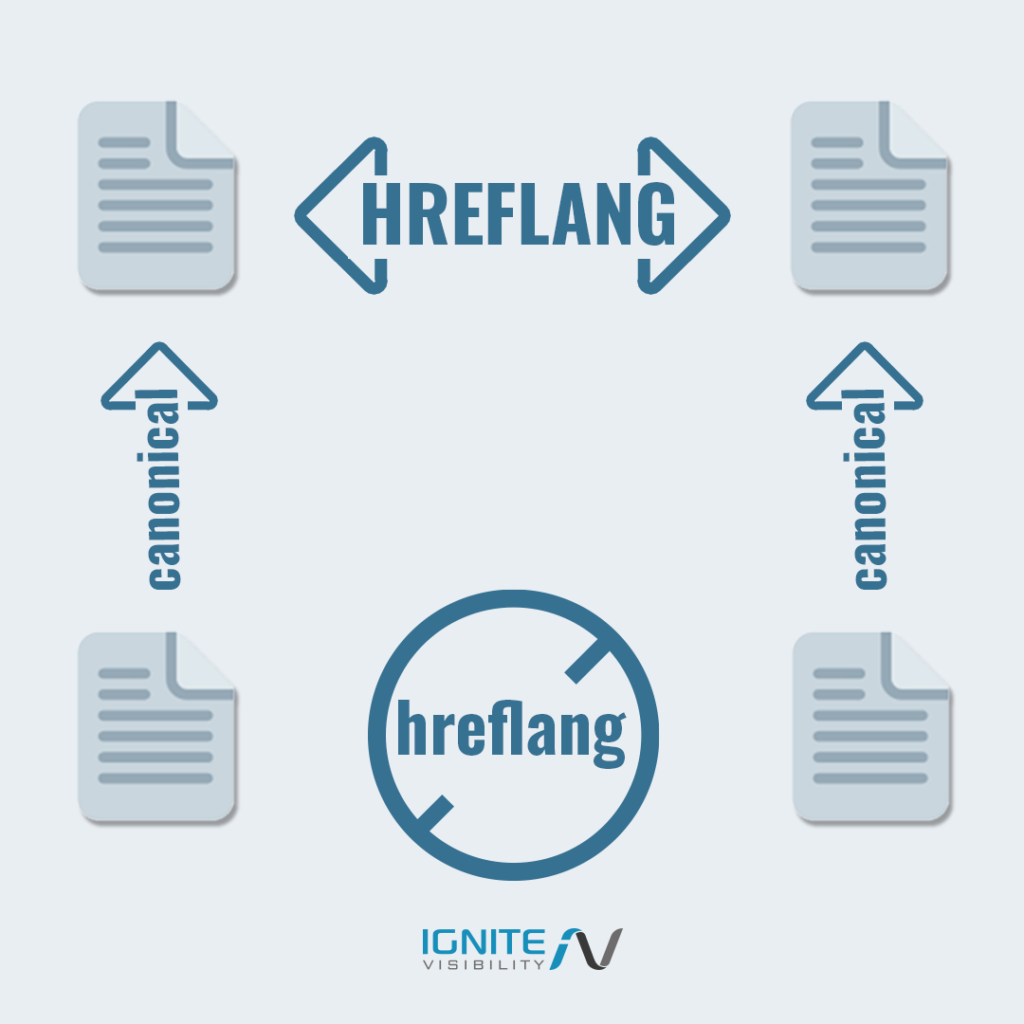
Here are four straightforward ways to debug those pesky international SEO targeting errors:
1. Make Sure Hreflang Tags Are In the Code, Not the Sitemap
Hreflang tags indicate to search engines what languages your content is in to help ensure that users see the content in results when searching in different languages. These tags should be in your site’s code to allow search engines to see it. If your hreflang tags are in the sitemap and not the code, switch it, as this is one of the more subtle international SEO mistakes.
When adding hreflang tags to your website, you can place them in multiple locations. However, many international SEO experts have had problems with implementing hreflang in sitemaps.
Google processes hreflang tags at the same time it crawls the page. This is true regardless of how you implement the tags. But putting hreflang in the site doesn’t mean Google will process those changes when you update the sitemap.
By putting hreflang in the code, you’re ensuring Google recrawls the page and updates the hreflang at the same time. This keeps your indexed content up to date.
The bigger, more global your company is and the more language pages you need to publish, the trickier hreflang gets. Do yourself a favor and make sure Google is up to date on all hreflang changes you make as the updates occur.
2. Use An International SEO Targeting Report to Debug Common Problems
Want to debug the most common problems? You can use the International Targeting report on Google Search Console.
The report has two sections:
1. Language: Track hreflang tag usage and errors on your site.
2. Country: You can set a country target that’s set for your entire site if you prefer.
Make sure Google has had time to crawl your pages. Then, visit the Language tab on the report to see if the site detects any errors.
How long does it take Google to crawl an updated page? Recrawling can take anywhere from a few days to a few weeks. Check back regularly using Google Search Console. This lets you watch search results data for the pages you are focusing on.
If that’s not enough for you, there are also many third-party tools available. Google doesn’t maintain or check these tools, but they can still be useful resources. Here are two options:
1. Aleyda Solis’s hreflang Tags Generator Tool
Aleyda Solis is an international SEO professional. Solis created a neat hreflang Tags Generator Tool for others to use.
This tool is helpful for developers or international SEO leads. It allows them to generate or change hreflang tags. You can use it to generate hreflang annotations for your pages. It also helps make sure you’re following Google’s specifications.
The tool uses the “correct values and syntax following Google’s specifications, with ISO 639-1 for languages and ISO 3166-1 Alpha 2 for countries.”
To use the tool, add the URLs you want to tag in the website form or upload a one-column CSV with up to 50 URLs.
2. Merkle’s SEO hreflang Tags Testing Tool
Technical SEO company Merkle has its own SEO hreflang Tags Testing Tool. (They also have a ton of other technical SEO tools at your beck and call).
According to the website, “hreflang annotations can be hard to implement properly. This tool allows you to quickly check if hreflang tags for a page (HTML and HTTP headers), or in XML Sitemaps, are correct.”
This tool is helpful for validating hreflang tags on a single live page. You can fetch or upload URLs as needed and test them through the tool.
Now that you know more about how to fix hreflang tags with errors, consider the other international SEO targeting errors out there that can hurt your international SEO efforts.
3. Consider Domains and Limit IP Serving
Two more international SEO targeting issues to avoid involve not considering their domains and relying too heavily on IP serving to connect with international users.
An example of the first issue would be the use of a .ca website for a business located in Canada. While this domain name would do fine in Canada, it may not appear in as many results in the U.S. or other countries. Instead, you may want to opt for a more widely used .com domain or use different domains for different audiences based on their location.
In addition, consider allowing users to overwrite IP serving for your website, which will keep people going to the right domain without hurting your SEO. For example, a user might be visiting a foreign country and attempt to access your site, only for them to go to the website in that country’s language when they’re not native speakers. Search engines could also have a hard time crawling your site across all the countries you’re targeting.
These issues make it a good practice to think about international domains while avoiding IP serving when it doesn’t make sense.
4. Resubmit Your Pages and Sitemap
You want to make sure that Google is indexing the latest version of your website. If you’re experiencing international SEO issues, resubmit your pages and sitemap to Google.
According to Google, “Doing so will help Google Search point users to the most appropriate version of your page by language or region.”
How do you resubmit your pages and sitemap to Google?
Start by signing in to Google Search Console. On the sidebar, go to your website. Hover over the index menu and click on Sitemaps. Remove any old or outdated sitemaps and then enter a new one. Click Submit and you’re ready!
You can also request a crawl and index for a specific URL. This is helpful if you’re focusing on updating a single page or just a few pages.
Learn how you can use a sitemap and other methods to tell Google about all the different languages and regional versions of your pages here.
Bonus: Add Country Codes to Titles
What if you cannot put proper canonical and hreflang tags cannot in place? It’s still recommended to have the country code in the title as an identifier. You can find a full list of country internet codes here.
It may also be a good idea to include the language in the title. Some countries speak many languages. For example, Morocco speaks French, Arabic, Spanish, and Berber. Belgium’s official languages include Dutch, French, and German. This can help clarify any confusion and better serve your end-users (which is Google’s goal, too).
FAQS: International SEO Targeting Errors
If you have any additional questions about international SEO mistakes and how to fix them, take a look at the following FAQs for more info:
1. What role does content localization play in effective international SEO?
With the help of content localization, you can translate and localize your website to provide users with the ideal user experience, regardless of where they’re located or their culture. Be sure to effectively translate content and localize it to match the corresponding cultures and languages you want to target to deliver the ideal experience.
2. Is there a difference between translation and localization in SEO?
While translation may help improve indexing and rankings in search engines, localization will help make your content more connective for international users while also improving searchability.
3. How often should I review and update my international SEO strategies?
The frequency of reviews and updates for international SEO strategies will depend on your specific goals. Depending on what you want to achieve, you might review and make any necessary changes on a weekly, monthly, or quarterly, which can help with fixing international SEO errors of all kinds.
4. Can multiple countries target a single language version of my site?
Yes, people across multiple countries can target a version of your website with one language. Google refers to this type of site as a “multi-regional” website, as opposed to a “multilingual” site that delivers content in multiple languages.
5. Does international SEO require a different keyword research approach?
In short, yes, you will need to take a different approach to keyword research from your approach to local or national keyword research. International research would involve looking for unique foreign-language keywords and using them in your content, keeping in mind that language and cultural differences could lead to different phrasing, depending on the country or culture. Simply translating your keywords into different languages won’t work.
Debug International SEO Errors ASAP
You know why international SEO issues can be such a burden on your search engine performance. Now you know a few ways to fix them, too.
Expanding your business to serve more people around the world is a big deal. The Ignite team wants you to succeed. These tips will help you deliver smooth, effective digital marketing. That way, you can serve your audience—wherever they may search from.
If you need some help with your international SEO efforts and other digital marketing strategies, turn to Ignite Visibility.
We offer reliable international SEO services that can help you develop a website that connects with users all over the world. We can get you started with this by conducting a thorough SEO audit, which will assess your current SEO and your site’s performance.
From there, we can help with multiple items, including:
- International keyword research
- Content optimization and localization
- Domain name creation and management
- Much more!
Regardless of your needs, Ignite Visibility is here for you. Get in touch with us today to get started on your next strategy!

